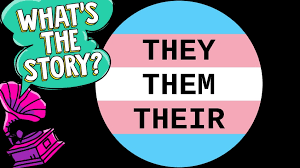For those of you learning English, you might have encountered the interesting situation where a single person is referred to as ‘they’. Consider for a moment the following sentence in French and think about how it might be translated into English…
‘Si tu rencontrais dans la rue quelqu’un que tu ne connaissais pas, tu lui parlerais ?’
In French ‘lui’ is a gender-neutral pronoun which means either ‘to him’ or ‘to her’. In French all nouns are either masculine or feminine and so it easy to replace the noun with the appropriate pronoun. For example, ‘quelqu’un’ (someone) is masculine, and ‘une personne’ (a person) is feminine. The difficulty arises, therefore, when you try to translate this sentence into English. Would it be translated as;
‘If you met in the street someone whom you didn’t know, would you talk to him?’, or
‘If you met in the street someone whom you didn’t know, would you talk to her?’
As you probably know, genders in English are used mainly only for people or animals, so, usually, learners of the language don’t have the same challenge of trying to remember which gender to attribute to which noun. This possible linguistic ‘advantage’ encounters problems, however, when attempting to use the correct pronoun to replace the original noun if it was a ‘person’ whose gender isn’t specified. In English ‘someone’ (just like ‘anyone’ or ‘a person’ or indeed any other gender non-specific noun or pronoun, such as ‘a stranger’, ‘a friend’ or ‘a colleague’, etc.) doesn’t have a gender, as it does in most other European languages. Consequently, we can’t use ‘him’ or ‘her’ as the pronoun. So, what do we do? You could say ‘…would you talk to him or her?’ which some people would do, but which, in my humble opinion, is just too ‘wordy’.
So, in the example above, we would say;
‘If you met in the street someone whom you didn’t know, would you talk to them?’
But, I hear you ask, how can ‘they’ be a pronoun for one person? The answer is that ‘they’ is not only a plural pronoun.
This interesting word is also a singular pronoun, and it has been for hundreds of years. As far back as the Middle Ages, ‘they’ has been used as a gender-neutral pronoun, a word that replaced either he (a masculine singular pronoun) or she (a feminine singular pronoun), e.g., ‘Each passenger should show their ticket at the boarding gate’. ‘Each passenger’ is singular, but we don’t know (and it is not important) what is the gender or sexual identity of each passenger in this situation, so ‘their’ is the appropriate pronoun.
Even Chaucer, Shakespeare, Jane Austen, and other well-known English literary used singular ‘they’. The American Dialect Society’s 2015 Word of the Year was the gender-neutral singular use of ‘they’, calling it “the only sensible solution to English’s lack of a gender-neutral third-person singular personal pronoun.”
There has always been some resistance to using ‘they’ as a singular pronoun because of the confusion it can cause, grammatically. It does seem to be somewhat of a ‘mistake’ in the English language. It’s as if in its evolution, this anomaly was somehow never addressed, and a more suitable ‘new’ pronoun was never found! As a teacher of English, I know that my students struggle with the idea of treating something singular as ‘more than one’. In older, perhaps less flexible forms of English, you might have encountered the above sentence being written as, ‘If you met in the street someone whom you didn’t know, would you talk to him? ’where ‘him’ would have acted as the pronoun both for ‘him’ and ‘her’, as is the case for ‘lui’ in French. However, while to a French ear ‘lui’ as a singular indirect object pronoun sounds completely natural as a way of referring to either a masculine or feminine noun, the same cannot be said for ‘him’. To an English ear, there is no ambiguity; the speaker is clearly talking about the ‘someone’ being a man, thus leaving them open to claims of sexism – the ‘someone’ could have been a woman.
So, we say ‘they’. It’s not perfect, but it does the job. It is actually an extremely useful word when we don’t know the gender of the person we’re talking about. I even used a variation of it above. Did you catch where I said ‘them’ in the last sentence of the previous paragraph? Scroll back up!
Nowadays, it’s also an extremely important and useful way for people who don’t identify with the binary genders of female and male to describe themselves, because they and them are not explicitly gendered. (They/them/their can be non-binary pronouns.)
So, if anyone tells you that we don’t have a gender-neutral pronoun in English, tell ‘them’ that ‘they’re’ mistaken!
Thanks for reading.
If you have enjoyed reading this blog, please ‘like’ it and share it with your friends and colleagues, and if you know anyone who might be interested in my online one-to-one lessons, please do ask them to contact me to discuss how I can help them to excel in English.
Thank you,
Martin


Recent Comments